The fashion for hoops was revived in 1711, in which year was published in England “A Panegyrick upon the Late, but most Admirable Invention of the Hoop-Pettycoat.” A few years later, (1726,) in New England, a three-penny pamphlet was issued with the title, “Hoop Petticoats Arraigned and Condemned by the Light of Nature and Law of God,” by which it would seem that our worthy ancestors did not approve of the fashion. In 1728 we find hoop-skirts and negro girls and other “chattels” advertised for sale in the same shop!
The celebrated song, “Tobacco is an Indian weed,” is traced to George Withers, of the time of James I. Perhaps no song has been more frequently “reset”; but the original version, as is generally the case, is the best.
One of the most satisfactory features of Chappell’s work is the thoroughness with which he traces the origin of tunes, and his acute discrimination and candid judgment. As an instance of this may be mentioned his article on “God save the Queen”; and wherever we turn, we find the same evidence of honest investigation. So far as is possible, he has arranged his airs and his topics chronologically, and presented a complete picture of the condition of poetry and music during the reigns of the successive monarchs of England. The musician will find these volumes invaluable in the pursuit of his studies, the general reader will be interested in the well-drawn descriptions of men, manners, and customs, and the antiquary will pore over the pages with a keen delight.
The work is illustrated with several specimens of the early style of writing music, the first being an illuminated engraving and fac-simile of the song, “Sumer is icumen in,”—the earliest secular composition, in parts, known to exist in any country, its origin being traced back to 1250. It should have been mentioned before this that the very difficult task of reducing the old songs to modern characters and requirements, and harmonizing them, has been most admirably done by McFarren, who has thus made intelligible and available what would otherwise be valuable only as curiosities.
1. Folk-Songs. Selected and edited by John Williamson Palmer, M.D. Illustrated with Original Designs. New York: Charles Scribner. 1861. Small folio. pp. xxiii., 466.
2. Loves and Heroines of the Poets. Edited by Richard Henry Stoddard. New York: Derby & Jackson. 1861. Quarto, pp. xviii., 480.
3. A Forest Hymn. By William Cullen Bryant. With Illustrations of John A. Hows. New York: W. A. Townsend & Co. 1861. Small quarto, pp. 32.
We have no great liking for illustrated books. Poems, to be sure, often lend themselves readily to the pencil; but, in proportion as they stand in need of pictures, they fall short of being poetry. We have never yet seen any attempts to help Shakspeare in this way that were not as crutches to an Indian runner. To illustrate poetry truly great in itself is like illuminating to show off a torchlight-procession. We doubt if even Michel Angelo’s copy of Dante was so great a loss as has sometimes been thought. We have seen missals and other manuscripts that were truly illuminated,—




